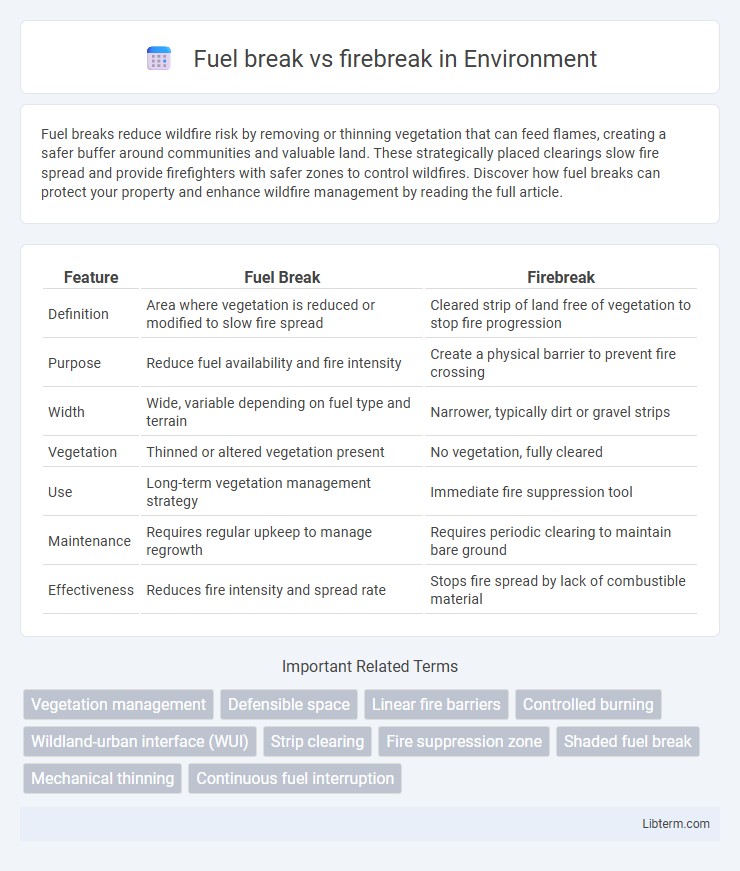Fuel breaks reduce wildfire risk by removing or thinning vegetation that can feed flames, creating a safer buffer around communities and valuable land. These strategically placed clearings slow fire spread and provide firefighters with safer zones to control wildfires. Discover how fuel breaks can protect your property and enhance wildfire management by reading the full article.
Table of Comparison
| Feature | Fuel Break | Firebreak |
|---|---|---|
| Definition | Area where vegetation is reduced or modified to slow fire spread | Cleared strip of land free of vegetation to stop fire progression |
| Purpose | Reduce fuel availability and fire intensity | Create a physical barrier to prevent fire crossing |
| Width | Wide, variable depending on fuel type and terrain | Narrower, typically dirt or gravel strips |
| Vegetation | Thinned or altered vegetation present | No vegetation, fully cleared |
| Use | Long-term vegetation management strategy | Immediate fire suppression tool |
| Maintenance | Requires regular upkeep to manage regrowth | Requires periodic clearing to maintain bare ground |
| Effectiveness | Reduces fire intensity and spread rate | Stops fire spread by lack of combustible material |
Introduction to Fuel Breaks and Firebreaks
Fuel breaks and firebreaks are crucial wildfire management tools designed to mitigate fire spread by removing or modifying vegetation. A fuel break typically involves thinning or removing flammable materials to reduce fire intensity, while a firebreak is a cleared strip of land devoid of vegetation that acts as a physical barrier to fires. Effective implementation of these strategies depends on landscape characteristics, vegetation types, and fire behavior patterns.
Defining Fuel Breaks: Purpose and Design
Fuel breaks are strategically cleared or thinned areas designed to reduce the amount of flammable vegetation and slow wildfire spread, enhancing safe firefighting access. Unlike firebreaks, which are often completely cleared strips of bare soil, fuel breaks retain some vegetation but lower fuel density to interrupt fire continuity. Their purpose centers on modifying fire behavior by creating defensible spaces that protect property and natural resources while facilitating controlled burns and suppression efforts.
What is a Firebreak? Key Features Explained
A firebreak is a gap in vegetation or combustible material designed to stop or slow the spread of wildfires by removing fuel sources. Key features include its strategic placement across fire-prone areas, varying widths based on terrain and vegetation type, and construction methods such as plowing, clearing, or using natural barriers. Unlike fuel breaks that reduce vegetation density, firebreaks create a complete barrier to fire progression, enhancing wildfire control and safety.
Main Differences: Fuel Break vs Firebreak
Fuel breaks are strategically managed strips of vegetation designed to reduce the intensity of wildfires by limiting available fuel, while firebreaks are cleared or excavated gaps devoid of combustible material meant to stop or redirect fire spread. The primary difference lies in their construction and purpose: fuel breaks modify existing vegetation to slow fire progression, whereas firebreaks create physical barriers to halt flames entirely. Firebreaks require more intensive preparation and maintenance compared to fuel breaks, which are often integrated into landscape management plans for ongoing wildfire risk reduction.
Methods of Creating Fuel Breaks
Fuel breaks are strategically cleared or thinned zones designed to reduce combustible vegetation intensity and continuity, using mechanical thinning, prescribed burns, and herbicide treatments to minimize wildfire spread. Mechanical thinning involves selective removal of smaller trees and underbrush with machinery or hand tools, preserving larger, fire-resistant trees. Controlled or prescribed burns reduce accumulated fuels by carefully igniting low-intensity fires under specific weather conditions, while herbicides target invasive or high-fuel plants, maintaining the break's effectiveness over time.
Techniques for Constructing Firebreaks
Techniques for constructing firebreaks involve creating clear, vegetation-free zones using mechanical clearing, controlled burning, or hand tools to remove combustible materials and expose mineral soil. The width and placement of firebreaks are strategically determined based on vegetation type, terrain, and anticipated fire behavior to effectively halt or slow wildfire spread. Regular maintenance is crucial to ensure firebreaks remain effective by preventing regrowth and accumulation of flammable debris.
Effectiveness in Wildfire Management
Fuel breaks reduce wildfire intensity by removing or thinning vegetation, slowing fire spread and improving firefighter access. Firebreaks create clear, vegetation-free barriers that stop fire advancement by eliminating available fuel entirely. Both methods enhance wildfire management effectiveness, with fuel breaks managing fire behavior and firebreaks serving as direct physical obstacles.
Environmental Impacts of Fuel Breaks and Firebreaks
Fuel breaks and firebreaks play crucial roles in wildfire management by reducing combustible vegetation, yet their environmental impacts differ significantly. Fuel breaks often involve selective thinning and controlled removal of underbrush, which can preserve soil stability and promote biodiversity, whereas firebreaks typically require complete vegetation clearance, leading to soil erosion and habitat fragmentation. Both methods alter local ecosystems, but carefully planned fuel breaks minimize negative effects on wildlife and water quality compared to the more disruptive firebreaks.
When to Use Fuel Breaks vs Firebreaks
Fuel breaks are most effective in areas with dense vegetation to reduce available combustible material and slow fire spread, ideal for preventing wildfires from reaching critical zones. Firebreaks are best used when an immediate, physical barrier is needed to stop or redirect active fire lines, often constructed with cleared soil or non-flammable surfaces. Choosing between fuel breaks and firebreaks depends on the fire's stage, vegetation density, and landscape, with fuel breaks serving long-term prevention and firebreaks designed for rapid response.
Future Trends in Wildfire Mitigation Strategies
Fuel breaks and firebreaks are evolving with the integration of advanced remote sensing technologies and AI-driven risk assessment tools to enhance wildfire mitigation efficacy. Future trends emphasize the use of precision mapping and real-time data analytics to optimize the placement and maintenance of fuel breaks, reducing combustible vegetation strategically to disrupt wildfire spread. Increasing research into climate-adaptive materials and vegetation management practices will further strengthen firebreak resilience against more frequent and intense wildfires driven by climate change.
Fuel break Infographic

 libterm.com
libterm.com